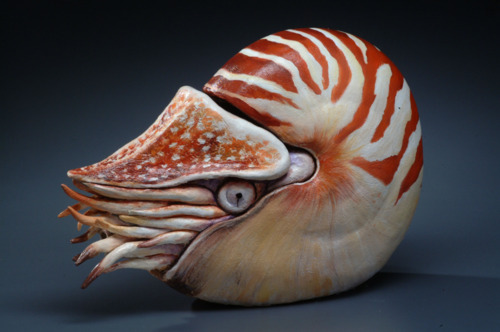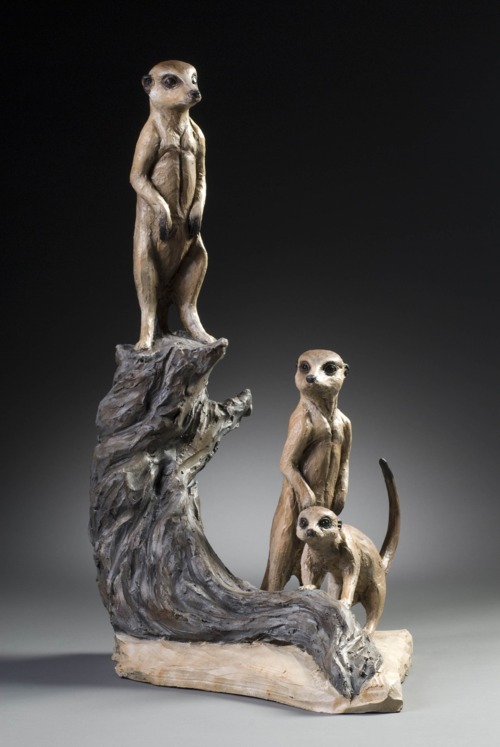
You are both a painter and a ceramic artist; is one medium closer to you than another?
Both mediums have equal places in my heart. It mainly depends on the subject or idea I have; clay is sometimes better at conveying my passion or idea then paint is. There is nothing like the feel of clay in hand. I can say in Ceramics what I can not with paint. Clay is felt with all, the eyes, hands, and the heart. No other medium can do this. Clay comes from the earth and has that feeling of being alive if sculptures right. If you look closely at a ceramic sculpture, you can see the finger marks, the hand prints — it is made by the hand and touch of the artist.
I love in clay that, as an artist, I can take that lump of clay and make it into something magical, something others can touch and see the passion I had for my idea. This is what drew me to clay as my medium.
There is a visible fascination for the world of animals reflected in your work; where does this interest come from? Tell us more about the subjects you explore.
Since childhood, I have had and felt a closeness with animals. I have lived in the company of animals more than in the company of people. So naturally, I would follow that path with my art. In Ceramics, I could finally convey the gesture and mood of an animal with the strokes of the clay without a lot of details.
I have always been more interested in capturing the spirit of an animal or its essence than making an exact model of an animal. Clay freed me up to be able to do this, with quick clay marks here, and strokes of clay there. Clay has that wonderful freedom to it. And Clay sometimes has it’s own ideas about how a piece will come about, that I might not have thought of until I was in the middle of sculpting it. I am drawn to the less familiar animals in my sculptures, like the blue ring octopus, Okapi or fruit bats. These animals fascinate me. Trying to make clay appear like soft fur is the challenge and the fun, like with my Koala sculpture.
Your works are incredibly realistic. Before proceeding to work, do you spend much time in the nature, studying animals? Where do you research?
Yes, I spend a lot of time researching my subjects. I am mainly limited to zoos and nature centers. In order for me to convey in clay an animal, I have to know enough about how that animal moves, it’s size, it’s character, and anatomy.
I have always been more interested in the gesture and emotion, which is the main characteristic I want to convey in my sculptures. If you look closely, there isn’t a lot of details. Yet, I still have to know enough anatomy, like the fact that the middle toe on the back feet of a kangaroo is a lot longer, or or that a Koala’s paws and feet are very complicated.
I do spend a lot of time sketching and just watching animals at the zoos.

Meerkats Alert, 2008, 25” x 24” x 15”, raku clay, hand built solid, hollowed for firing, low fired, cold finish acrylic and wax
More recently you had two solo shows concerning two different topics: Alzheimer disease in “Within the Mind” and endangered animals in “Endangered”. Tell us more about the shows.
“Within the Mind” show came about because my mother is in the mid stages of Alzheimer’s disease. I help care for my mother and noticed it was hard to find out information or the best ways to help her. Also, she had lost her voice, and I felt like I could give her voice back with my artistic skills. As a child, my mother was the one person who always supported and encouraged me to be an artist. Without her support, I might have had to give up my dream. It is difficult to see one’s mom slowly disappear before your eyes because of Alzheimer’s disease. It was my way of honoring my mother while she could still come and understand, plus a place for me to put the feelings I had about losing her. Clay will absorb the emotion of an artist while he sculpts. I had to put those feelings somewhere, and clay and paint are the languages I chose. All the paintings and sculptures for that show tell a story about different aspects of the disease. As for my “Endangered animals” show, I could show you the depth in a Lion’s eyes or the beautiful form of a Koala. It was important to me to take my talents as an artist to bring more awareness to issues in our society. I am a member of the Artists for Conservation and will continue to help protect animals throughout the world. They cannot protect themselves, so it is up to us.
Are your works from the “Endangered” series a statement for wildlife conservation? How would you like your works to be perceived by the viewer?
Yes, it is a statement towards more protection and conservation. For example, I want to show the beautiful face of a Panda, to bring awareness that in the coming years you might never get to see that face anymore. Animals have earned their place on the Planet, and it is up to us to protect them. In my ceramic sculptures, I am drawn to the less familiar animals, the solitary ones. I feel a kinship with those, because as an artist I spend a lot of my time in the studio, in solitary work.
By Andra Baban
Published in Ceramics Now Magazine Issue 2
View Cindy Billingsley’s profile on Ceramics Now.
Visit Cindy Billingsley’s website.




















